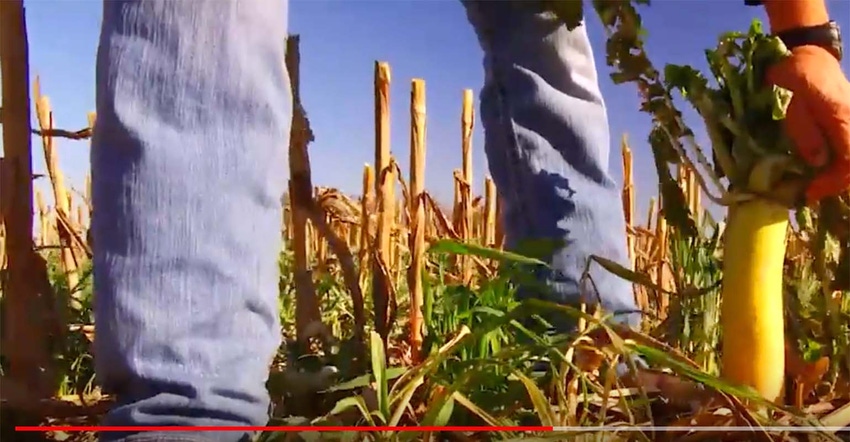February 22, 2018

The regional winners of the 2018 Conservation Legacy Awards have been announced:
Mark Schleisman, Lake City, Iowa (Midwest Region)
David and Linda Burrier, Union Bridge, Md. (Northeast Region)
Grant Norwood, Mansfield, Tenn. (South Region)
Each winner will be recognized at the ASA Awards Banquet on Feb. 28, 2018, at Commodity Classic in Anaheim, Calif. During the banquet, one of the farmers will be chosen as the national winner.
The Conservation Legacy Award is a national program designed to recognize the outstanding environmental and conservation achievement of soybean farmers.
A national selection committee, composed of soybean farmers, conservationists, agronomists and natural resource professionals, evaluated nominations based on each farmer’s environmental and economic program. This program is sponsored by ASA, BASF, Monsanto, Corn & Soybean Digest, the United Soybean Board/Soybean Checkoff and Valent.
Midwest Region winner
Mark Schleisman heads up M&M Farms, a diverse family operation in Calhoun County, Iowa. M&M Farms grows 4,500 acres of crops, including 2,000 acres of popcorn; manages 360 cow-calf pairs; and finish approximately 30,000 head of pigs.
While M&M Farms is located in an area where agriculture can flourish very well, it is also under a significant amount of scrutiny from an environmental standpoint. Calhoun County was one of three counties targeted by the Des Moines Water Works in a lawsuit against county drainage districts for discharging high levels of nitrates. Des Moines uses the Raccoon River as a primary water source. The suit was later dismissed
The Schleisman farm is in the Elk Run watershed, a tributary to the Raccoon River and a source of concern about nitrate. As part of a demonstration project directed by the Iowa Soybean Association in cooperation with a number of partner organizations, Schleisman installed a couple of edge-of-field practices designed to significantly cut nitrate contribution to the Raccoon River.
One of these practices is a saturated buffer. It stores water under field buffers by diverting tile water into shallow laterals that raise the water table within the buffer, thus slowing outflow. The other edge-of-field treatment process is a bioreactor. It consists of a buried pit filled with a carbon source (wood chips) through which tile water is diverted. The carbon provides a food source for microorganisms; they use nitrate to metabolize the carbon, converting the nitrate to harmless atmospheric nitrogen gas.
“I have seen nitrate levels entering the bioreactor running 15 to 22 parts per million,” Schleisman said. “It is exiting the bioreactor at less than one part per million.”
Northeast Region winner
Dave and Linda Burrier also know what it is like to live in a highly scrutinized farming area, particularly when it comes to protecting water quality. Their farm in Union Bridge, Md., is within 50 miles of the Chesapeake Bay and situated against the backdrop of the Appalachian Mountains. The farm is in a valley served by two well-traveled roads.
“We feel we are in a fishbowl,” Linda Burrier said. “We are always very conscious of what people can see. We try to keep our farm looking picturesque and our landlords expect us to care for their land in the same way.”
Regulators have pointed to agriculture as the largest source of pollution in the Chesapeake Bay, and in 2010, established Total Maximum Daily Load (TMDL) regulations as a way to restore and protect the Chesapeake Bay and all the rivers and streams that feed into it. The Bay TMDL, set by the EPA under the Clean Water Act, set targets for reduced nitrogen, phosphorus, and sediment pollution.
One way the Burriers demonstrate their conservation commitment is through the use of strip cropping. Their crops are grown in long narrow strips and the farm’s 1,800 acres support a diverse mix of crops, including corn, soybeans, wheat, alfalfa, hay, and grass hay.
“All our fields have a certain amount of slope,” David Burrier explained. “Alternating crops in these strips allows us to control soil erosion, control sediment loss and retain nutrients.”
In non-crop areas, the Burriers have installed and maintain grass waterways and buffers to reduce runoff. The TDML regulation has required them to have a nutrient management plan, which has greatly increased their record-keeping. Operating under TMDL regulations, the Burriers look for ways to efficiently provide crop nutrients to maximize production while minimizing potential nutrient losses.
South Region winner
Grant Norwood, a fifth-generation farmer, grows 3,000 acres of crops in Henry County, Tenn. Going the extra mile for conservation has been the family’s approach to farming all the way back to the late 1800s, when his great-great-grandfather began farming from his log cabin in the Pleasant Hill community near Mansfield.
At Norwood Farms, they also implement a variety of conservation practices including cover crops, establishment of pollinator and wildlife habitats, installation of water and sediment control basins, and they are 100% no-till.
Norwood Farms’ efforts to be efficient and environmentally friendly even extend to their grain storage site, which uses three-phase electricity. The facility also uses a grain management system (Intelliair Bin Manager), which monitors temperature and moisture in the bins when grain is present.
“It maximizes the cooling and drying of the grain, reducing the energy because fans are only used when conditions are optimum to do the job,” Norwood said.
“Our family’s focus on sustainability from one generation to the next is how we have been able to continue to farm the same land for five generations,” Norwood added. He further explained that it may take some time to see the benefits of certain conservation practices, but they will pay back over time. “You have to have a long-term mindset, but the economic benefits will carry over to benefit future generations,” he said.
Source: American Soybean Association
You May Also Like




